Experimenting With 2nd Shoot
Normally when trying to achieve abstract results on photographs I would use different images or textures as layers to do this but after a little bit of trying it was difficult to find anything that worked well so I decided to use different colour and effect layers to see what kind of effect they could give to my images. There are lots of different options that photoshop has for me to use like this, the first of which is the Posterize Tool.
These two images were created by using the posterize tool. The first one is just the posterize layer placed on top of the image and the intensity reduced a little. After I had created the first image I decided that I liked the effect but there was something missing from the image, it felt a little too disconnected from the original image but I still really liked the effect of the reflection on the water’s surface. To try and overcome this I used a layer mask to remove the posterizing effect from the model’s body, head, chin and arms. This does not make it look that different from the previous image but on its own I much prefer having the slight posterization effect on the water but still being able to have the model looking normal.
Even Though the shoot was meant to be based around colour while editing this image I decided to try out the black and white tool to see what kind of effects I could come up with. The first experiment with black and white was to just add a black and white layer to the posterized image layers in Photoshop. This gave an unusual effect to the image, the posterization is particularly noticeable on the subject’s neck, the solid blocks of dark grey make the image lose some of its feeling of reality, the image looks overly fake I think. Insite of this I still liked the B&W and wanted to pursue it further on this image, so I started again with the original image as my base. The first step was to add the black and white layer, but when I added this layer I did not just leave it as it was, because doing this it just made the image much more boring.
Instead I changed the levels of the different colours to change how dark all the different colours were represented. The image on the right above shows what the image looks like with just a regular B&W layer added and the image above on the left shows the final settings that I used to create the final B&W image. In addition to this I added a gradient map layer that only had a little effect but really helped to make the watershine on the model’s chest show up better and drew the dark background in around him more. I also used the sharpen tool to help with the general softness that comes from shooting underwater and the dirty condition of the pool.

The other image that I decided that I wanted to try and experiment with is this one. It does not look very clear in this state but after editing it I got a really abstract effect to it and it became much sharper. The screenshot below shows the layers used to create the image.

For this image I first tried to use just a black and white layer to do the same thing as before but this ended up just like the first B&W attempt for the previous image and even adding the gradient map layer it did not look how I the other image did, because of this I decided to take a different approach. This mostly involved just randomly adding different effect layers and playing around to see what would come out. This image was one of these random experiments.

By adjusting the channel mixer and B&W layers I managed to get really unusual effect whereby all of the model’s makeup which was a light blue colour turned to a very stark black and really stands out where it had not before. This, combined with the reflections behind the model really make this an unusual image to look at, there is lots going on and yet the viewer’s eye is drawn to to the model’s face still through the regular shapes of the dots of his makeup which starkly contrast the flowing irregular patterns of the water’s reflections. An element that was not very easy to see in the original image was the bubbles in front of the model’s face which show up really well in this version. Having the dark background to the image with its tentacle like lengths of darkness that almost seems to be drawing the model under the water and into its depths, combined with the model’s pained expression (he could not stand getting water in his eyes, hence the squinting) really add a sense of drama and feat to this image. The image lends itself well to the notion of fear and mystery that surrounds water that I have already looked at. The image is not exactly how I would like it to look though, the model’s chest and arms are kind of lost into the background, they do not stick out from the background, in a way this is good because it does not detract from the model’s facial expressions that are the main feature but I would have still liked for them to be a little more visible. I am also not too keen on the vignetting at the image’s corners. This element, although it does not take much away from the image, draws in too much from the bottom left and the top right of the image, making it seem like the “drawing in” effect is overdone. I was oping that I would be able to obey the rule of thirds for this image a little better too but this did not work out perfectly ether. The background over the model’s right shoulder while taking up a large proportion of the frame does not take up two thirds and so does not fit well, I tried cropping the image so that this would work but it could not be done at the same aspect ratio without losing too much of the background of the background, and I did not want to change the aspect ratio. Overall though I really like this image, it is abstract and involves the ideas of colour and water by replacing what would be grey and white in a B&W image was blue, the traditional colour of water in a very non traditional image.

Unlike the previous image this one managed to follow the rule of thirds, with about a third of the image being a dark mass overseeing the model it works quite well I feel. I really like how the reflections on the underside of the water’s surface worked out, they act as a sort of set of leading lines almost that lead towards the model’s shoulders and alluded to something more existing above the water but by not showing his face removes this reality. The empty spaces on the right of the image are not completely empty, I think this really helps the image in not being an uninteresting image, the slight ripples and the fading out arm fade the image away and ease the viewer out of the scene instead of having a solid cut. The idea of mystery and power is also conveyed through this image because of the low angle of the photograph, the model’s face being obscured makes you wonder who they are and why we cannot see their face. The B&W really helps with the abstraction for this image, giving it a wholly unnatural look to it making the water seem murky and asif the subject is being pulled back into the darkness or if he is emerging from the darkness towards the viewer. I do wish that this images could have had the same kind of effect in color because this was the original intention of the shoot, but sometimes things don’t work out as planned and you need to adapt to what you have to be able to produce something.
This video is not important to the blog post but the reflections of the waves reminded me of the results that came from this shoot so I thought that I would just put this here.







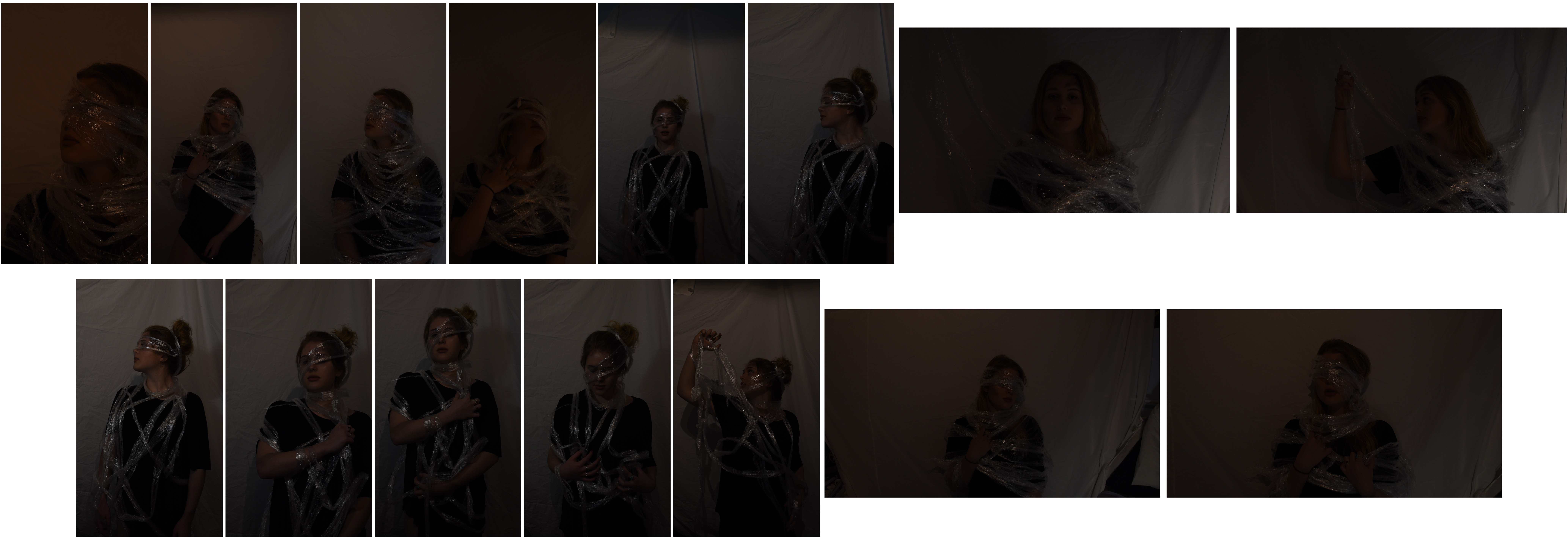
 The first image displayed full and in colour above is a side portrait, half boy shot, depicting the model carefully drapped in a plastic material. To create this look I used an interesting arrangement of cellophane and painted small purple smudges on my model for a bit of extra detail. The meaning behind this photograph is similar to one I explored in my last self portraiture shoot. The head facing away and closed eyes covered by plastic represents our failure to see what is literally right in front of our eyes. I like this clear metaphor I have created with the material along with the stern expression and strong jaw line of my model. The artificial lighting in this picture, as well as my alterations made in post production, has created some very interesting shadows and highlights. I really like the spot light effect I have added to all three of my outcomes as, for me, it symbolises how I am trying to ‘shine light’ on this grim subject. Overall I have chosen this image as my best result from this shoot because of its interesting composition, lighting and soft colour tones.
The first image displayed full and in colour above is a side portrait, half boy shot, depicting the model carefully drapped in a plastic material. To create this look I used an interesting arrangement of cellophane and painted small purple smudges on my model for a bit of extra detail. The meaning behind this photograph is similar to one I explored in my last self portraiture shoot. The head facing away and closed eyes covered by plastic represents our failure to see what is literally right in front of our eyes. I like this clear metaphor I have created with the material along with the stern expression and strong jaw line of my model. The artificial lighting in this picture, as well as my alterations made in post production, has created some very interesting shadows and highlights. I really like the spot light effect I have added to all three of my outcomes as, for me, it symbolises how I am trying to ‘shine light’ on this grim subject. Overall I have chosen this image as my best result from this shoot because of its interesting composition, lighting and soft colour tones.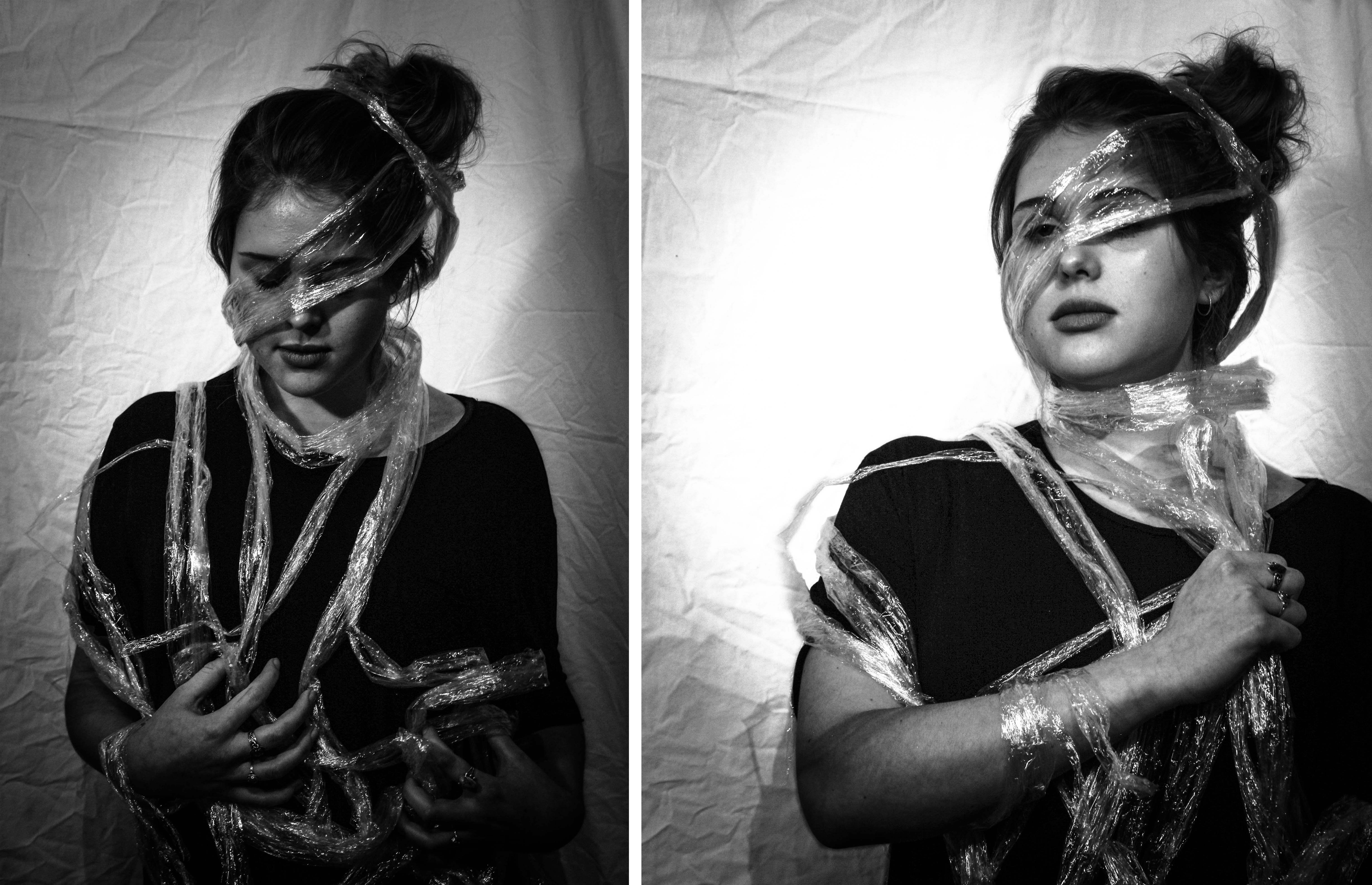 The next two black and white finals shown above are some of my other successful outcomes from this shoot, depicting the same material, but different poses and symbolic messages. The first photograph on the left shows the model standing straight, looking down at what she is wrapped in, with a simple composition. The message I was trying to get across with this pose was ‘having a look at what man-kind has created’. I like the modest look this composition has along with the dark contrast of the material and her hands. The plastic covering the models eyes also gives the image an abstract and almost fashion photography look. Lastly the image on the right shows the model gripping the plastic that is wrapped tightly around her neck. This obvious symbolism is to show my message through ideas of being trapped and suffocation, ultimately telling the story of the effect it has on animals and marine life. I chose this simple composition because it resembles a previously analysed portrait taken by my inspiration Matthew Lyn.
The next two black and white finals shown above are some of my other successful outcomes from this shoot, depicting the same material, but different poses and symbolic messages. The first photograph on the left shows the model standing straight, looking down at what she is wrapped in, with a simple composition. The message I was trying to get across with this pose was ‘having a look at what man-kind has created’. I like the modest look this composition has along with the dark contrast of the material and her hands. The plastic covering the models eyes also gives the image an abstract and almost fashion photography look. Lastly the image on the right shows the model gripping the plastic that is wrapped tightly around her neck. This obvious symbolism is to show my message through ideas of being trapped and suffocation, ultimately telling the story of the effect it has on animals and marine life. I chose this simple composition because it resembles a previously analysed portrait taken by my inspiration Matthew Lyn. When selecting my final outcomes out of the images above I wanted to make sure that I included a varied selection so that I can get across my symbolic point clearly. Below I have chosen four photographs (out of the 6 images above) that each show something quite different, whether it be the tone created by lighting , type of plastic material, or pose. When it came to editing these photographs the first thing I did to all of them was increase the exposure and play with the contrast. After this I judged each photograph individually and went through my normal editing routine of changing things like temperature, clarity, saturation, highlights and shadows. The reason I have included a mixture of colour and black and white outcomes is to tie into my first studio section, showing the common pollution issue of cigarette waste. Below are my final outcomes…
When selecting my final outcomes out of the images above I wanted to make sure that I included a varied selection so that I can get across my symbolic point clearly. Below I have chosen four photographs (out of the 6 images above) that each show something quite different, whether it be the tone created by lighting , type of plastic material, or pose. When it came to editing these photographs the first thing I did to all of them was increase the exposure and play with the contrast. After this I judged each photograph individually and went through my normal editing routine of changing things like temperature, clarity, saturation, highlights and shadows. The reason I have included a mixture of colour and black and white outcomes is to tie into my first studio section, showing the common pollution issue of cigarette waste. Below are my final outcomes…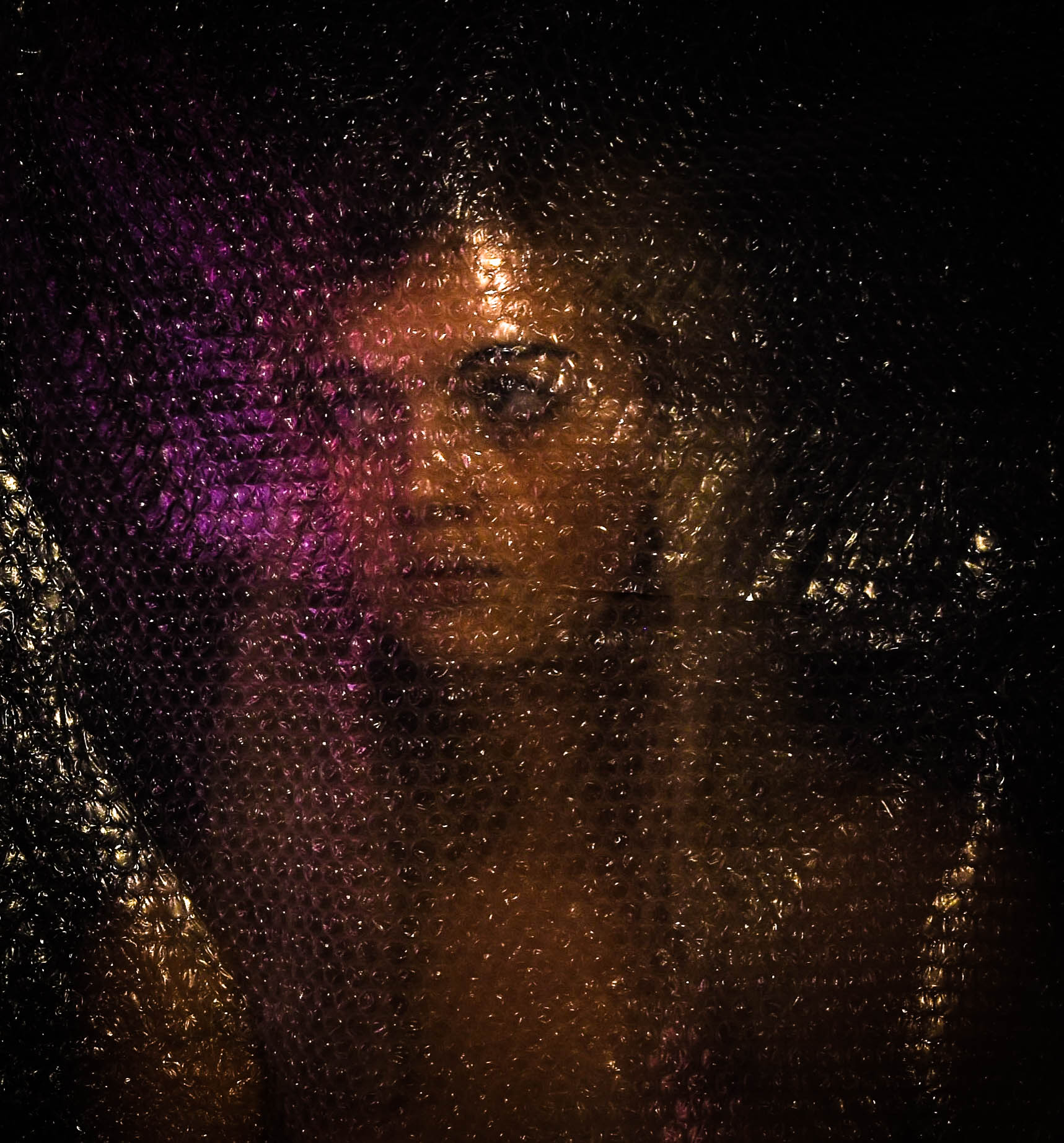 This first photograph is one of my favorites from this shoot, mostly because of the straightforward yet distorted composition and interesting light. To create this self portraiture piece I used a shutter button (to take the images), a black sheet as the background and a large piece of bubble wrapped that I have kept since last ordering something online. I like this piece as the colours and interesting light techniques shinning off the bubble wrap, reminds me of the beautiful plastic fashion photography done by Matthew Lyn. The symbolic meaning behind this image is not only to emphasis our connection to this global problem, but also to show our ignorance and how we do not allow ourselves to be affected by its gravity. This is represented by the fact I am looking away from the plastic that is right in front of my face, as well as my concentration on the pretty pink light that is being emitted from the side. As well as this, even though this shoot was purely symbolic and not documentary, I have managed to reuse a huge example of real plastic waste.
This first photograph is one of my favorites from this shoot, mostly because of the straightforward yet distorted composition and interesting light. To create this self portraiture piece I used a shutter button (to take the images), a black sheet as the background and a large piece of bubble wrapped that I have kept since last ordering something online. I like this piece as the colours and interesting light techniques shinning off the bubble wrap, reminds me of the beautiful plastic fashion photography done by Matthew Lyn. The symbolic meaning behind this image is not only to emphasis our connection to this global problem, but also to show our ignorance and how we do not allow ourselves to be affected by its gravity. This is represented by the fact I am looking away from the plastic that is right in front of my face, as well as my concentration on the pretty pink light that is being emitted from the side. As well as this, even though this shoot was purely symbolic and not documentary, I have managed to reuse a huge example of real plastic waste.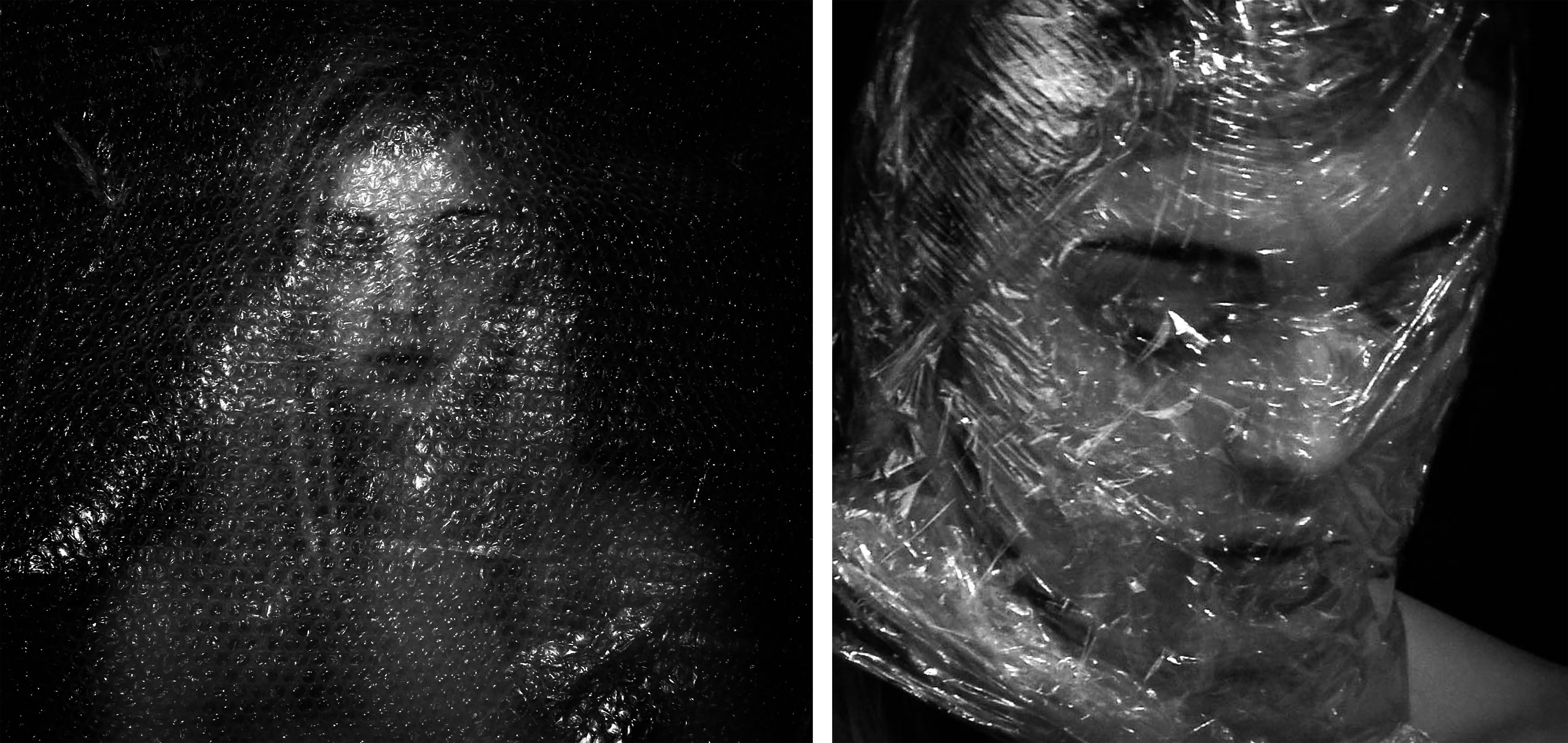 Here are two final outcomes that in my opinion, are not as meaningful as the larger ones above and below. The image on the left shows my second favorite from the bubble wrap shoot, made by simply taping the plastic above me and sitting underneath. The visual elements in this piece are a straight forward self-portrait, emphasised by dark edges and distorted by plastic. The meaning behind this photograph is linked very closely to the photograph above, showing our connection to this issue. Although the straight ahead look takes away from the representation, I do like this image for is black and white dramatic impact. The image on the right however is very different, showing one of my experimentations using cellophane instead of bubble wrap. To create this look I carefully wrapped the material around my head (making sure to create air holes as I went round) until it started to make interesting creases for the artificial light to bounce off. The meaning behind this photograph is very much to do with representing the way plastic kills animals and marine life. However the way I have wrapped myself in plastic also symbolises the way we do this the pretty much everything else. I like the clear message I can get across with this image however, in my opinion, its is not as good as the larger version I have presented below.
Here are two final outcomes that in my opinion, are not as meaningful as the larger ones above and below. The image on the left shows my second favorite from the bubble wrap shoot, made by simply taping the plastic above me and sitting underneath. The visual elements in this piece are a straight forward self-portrait, emphasised by dark edges and distorted by plastic. The meaning behind this photograph is linked very closely to the photograph above, showing our connection to this issue. Although the straight ahead look takes away from the representation, I do like this image for is black and white dramatic impact. The image on the right however is very different, showing one of my experimentations using cellophane instead of bubble wrap. To create this look I carefully wrapped the material around my head (making sure to create air holes as I went round) until it started to make interesting creases for the artificial light to bounce off. The meaning behind this photograph is very much to do with representing the way plastic kills animals and marine life. However the way I have wrapped myself in plastic also symbolises the way we do this the pretty much everything else. I like the clear message I can get across with this image however, in my opinion, its is not as good as the larger version I have presented below.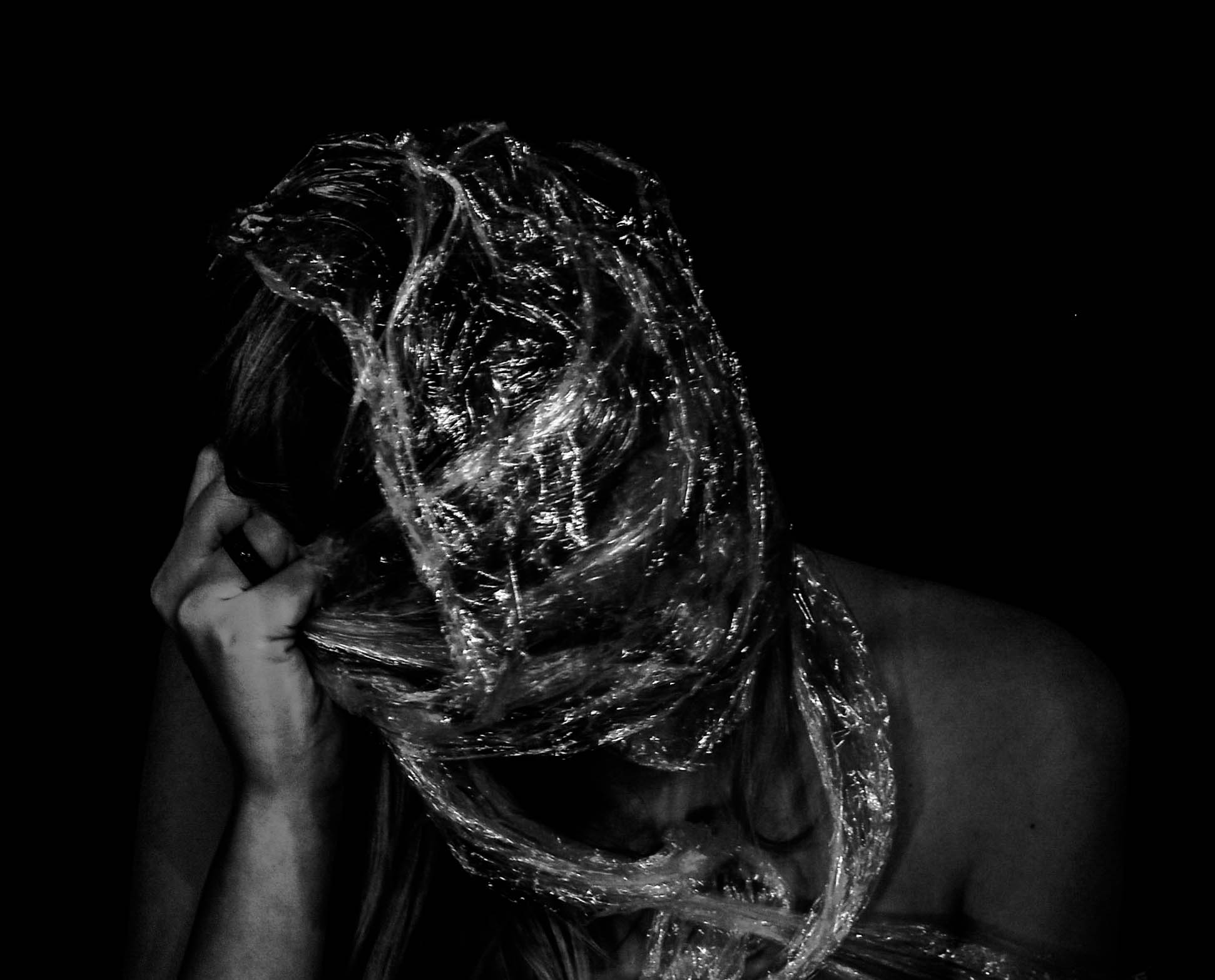 Lastly is my other favourite final edited outcome from this self portraiture shoot. This photograph depicts a very strong symbolic message using self portraiture, a home-made studio and cellophane. To create the plastic wrap look I bunched the cellophane together, making more of a textured surface for the light the reflect off, and tightly wrapped it around my head until I could pretty much no longer see. The reason I have decided to have bare shoulders in these images is because, after trying multiple tops, clothing was really taking away from the representation and making the photographs a lot less dramatic. For me, the symbolism behind this photograph in particular is very strong because of the composition, material and pose. Here I am representing not only the way plastic kills animals and marine life, but also the struggle these creatures endure. This is much clearer in this image, than it was in my last outcome, because of my visible struggle to break free, paired with the dramatic impact created by very dark contrast and 0% saturation.
Lastly is my other favourite final edited outcome from this self portraiture shoot. This photograph depicts a very strong symbolic message using self portraiture, a home-made studio and cellophane. To create the plastic wrap look I bunched the cellophane together, making more of a textured surface for the light the reflect off, and tightly wrapped it around my head until I could pretty much no longer see. The reason I have decided to have bare shoulders in these images is because, after trying multiple tops, clothing was really taking away from the representation and making the photographs a lot less dramatic. For me, the symbolism behind this photograph in particular is very strong because of the composition, material and pose. Here I am representing not only the way plastic kills animals and marine life, but also the struggle these creatures endure. This is much clearer in this image, than it was in my last outcome, because of my visible struggle to break free, paired with the dramatic impact created by very dark contrast and 0% saturation.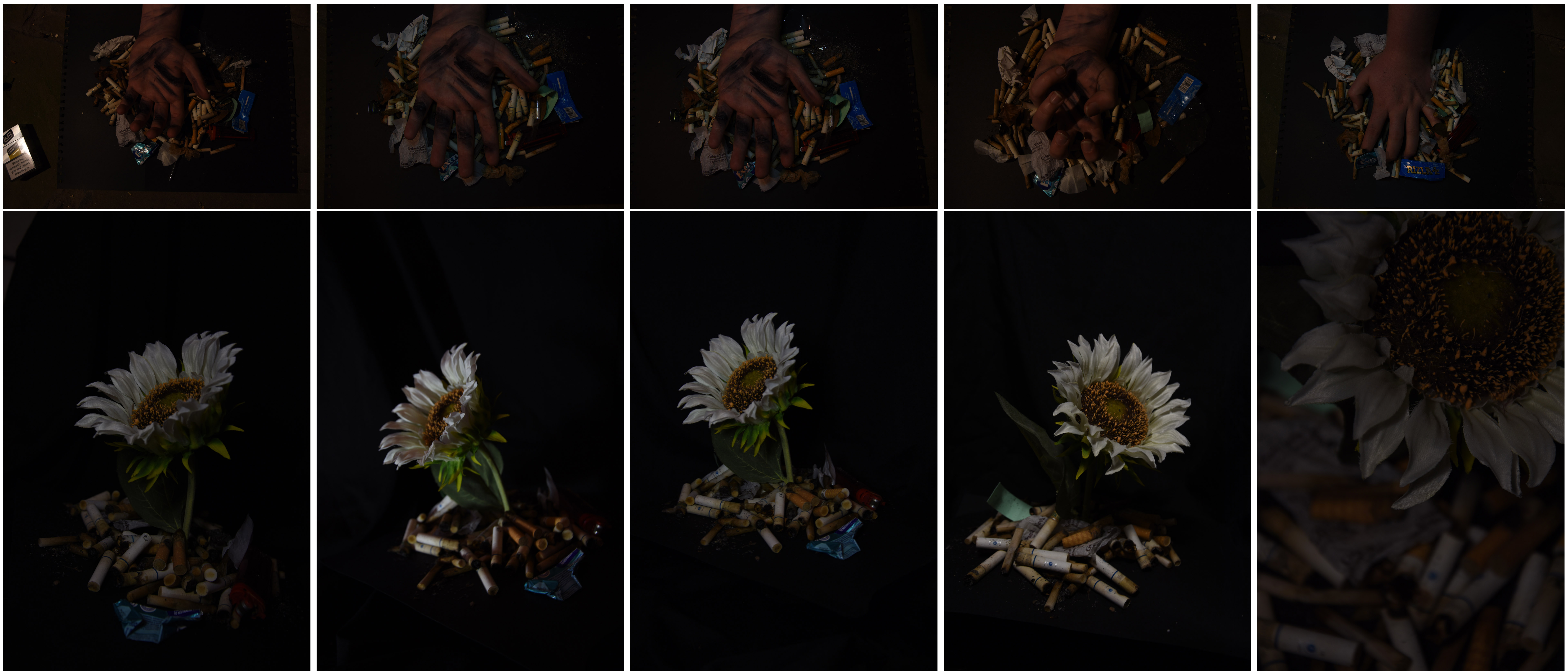 To really capture these scenes in a very dark, emotive and contrasted way, I took these photographs using a low shutter speed on the aperture setting of my camera. When choosing my final outcomes out of these 10 raw images above, I was looking for a simple composition with sharp definition and interesting lighting. The first thing I have done to edit my final outcomes is bring the level of the exposure, highlighting, contrast, and shadows up. By doing this my outcomes have become bright and dramatic pieces that, I think, really emphasis this pollution issue prominent on our Island. Below is a mixture of colour and black and white results, although I will not be using all of them for final pieces to represent my project, I really like the range of compositions and mixture of harsh and soft lighting…
To really capture these scenes in a very dark, emotive and contrasted way, I took these photographs using a low shutter speed on the aperture setting of my camera. When choosing my final outcomes out of these 10 raw images above, I was looking for a simple composition with sharp definition and interesting lighting. The first thing I have done to edit my final outcomes is bring the level of the exposure, highlighting, contrast, and shadows up. By doing this my outcomes have become bright and dramatic pieces that, I think, really emphasis this pollution issue prominent on our Island. Below is a mixture of colour and black and white results, although I will not be using all of them for final pieces to represent my project, I really like the range of compositions and mixture of harsh and soft lighting…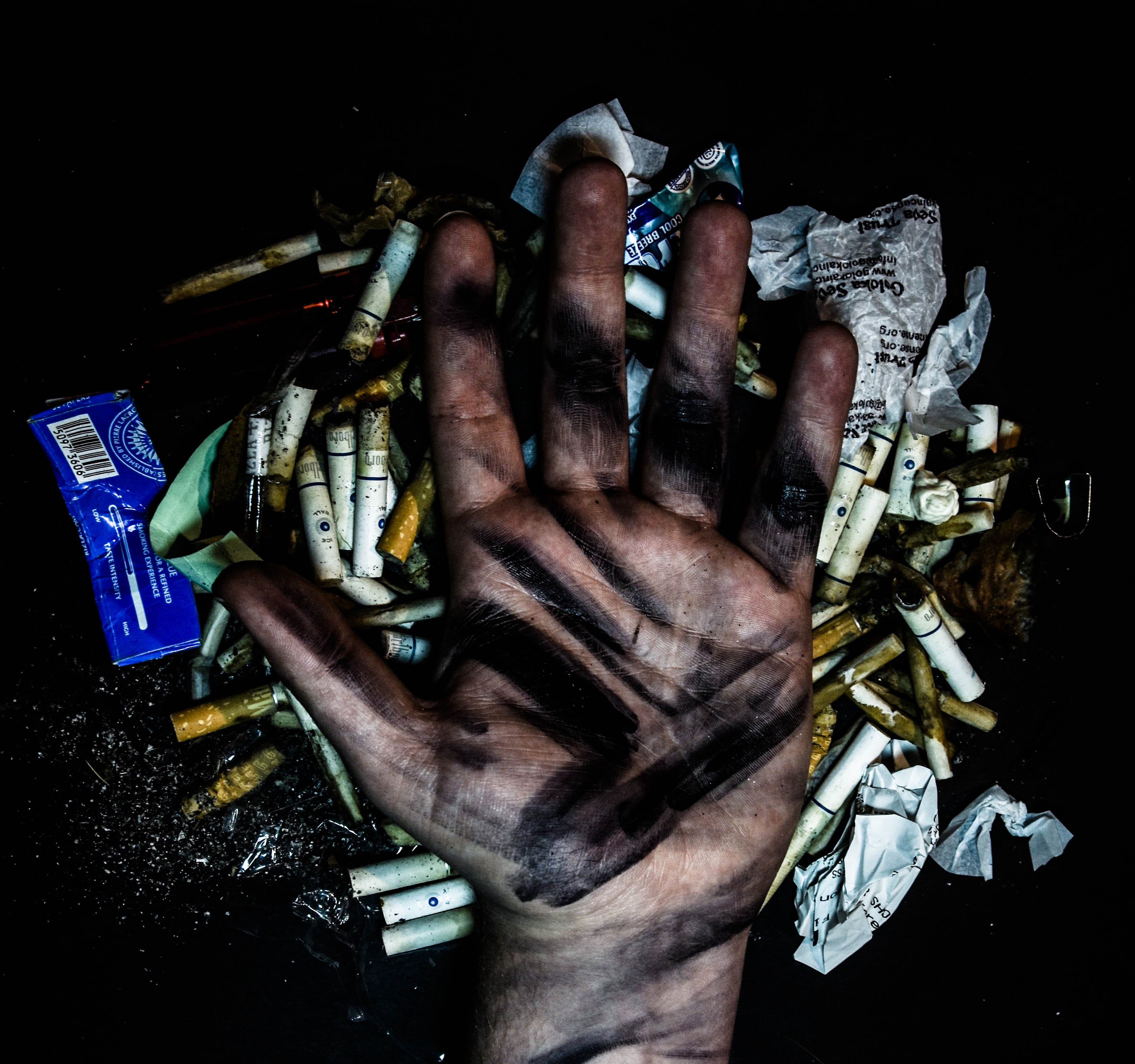 This photograph above depicts a straightforward composition of my models hand resting on black paper and surrounded by smoking waste. Because of my inspiration this shoot resembles the work of Gregg Segal as a representation of people compared to the waste they produce. Although, instead of full body portraits, I have used a hand as symbol of our species because it is what sets us apart and allows use to damage the environment in this way. To emphasis the scale of this problem I am representing, I have covered the hand in a black oily looking substance, showcasing our problem with mass production. To create these greasy marks I have used acrylic paints layered thickly and heavily in quick brushstrokes and captured the image whilst the paint is still wet. Overall I love this photograph’s appearance and feel it is the most successful for portraying this issue out of both of these two shoots. Aswell as this, this image is my favourite for its composition, contrast and striking / dramatic tone.
This photograph above depicts a straightforward composition of my models hand resting on black paper and surrounded by smoking waste. Because of my inspiration this shoot resembles the work of Gregg Segal as a representation of people compared to the waste they produce. Although, instead of full body portraits, I have used a hand as symbol of our species because it is what sets us apart and allows use to damage the environment in this way. To emphasis the scale of this problem I am representing, I have covered the hand in a black oily looking substance, showcasing our problem with mass production. To create these greasy marks I have used acrylic paints layered thickly and heavily in quick brushstrokes and captured the image whilst the paint is still wet. Overall I love this photograph’s appearance and feel it is the most successful for portraying this issue out of both of these two shoots. Aswell as this, this image is my favourite for its composition, contrast and striking / dramatic tone.
 Above is two of my colour results from the second shoot, made using a home-made studio, fake flower, artificial soft lighting and smoking waste. The image on the left is a full view of the scene I have created using very soft studio lighting. I love this effect the light source has as it represents the flower reaching towards, trying to survive. The reason I chose this image as one of my outcomes is because of the interesting focus and depth of field it shows. The image on this right however is a more abstract closeup version, and also one of my favourites from these two shoots. The reason I think this image works so well is the matching organgey / yellow colours displayed in both the cigarettes and the pollen of the flower. I also really like this closeup portrait composition with the darkly contrasted flower in the foreground and the pollution issue slightly burly behind. This depth of field for me represents the impact this problem has on natural things and our ability to ignore them, or in other terms, blur them out.
Above is two of my colour results from the second shoot, made using a home-made studio, fake flower, artificial soft lighting and smoking waste. The image on the left is a full view of the scene I have created using very soft studio lighting. I love this effect the light source has as it represents the flower reaching towards, trying to survive. The reason I chose this image as one of my outcomes is because of the interesting focus and depth of field it shows. The image on this right however is a more abstract closeup version, and also one of my favourites from these two shoots. The reason I think this image works so well is the matching organgey / yellow colours displayed in both the cigarettes and the pollen of the flower. I also really like this closeup portrait composition with the darkly contrasted flower in the foreground and the pollution issue slightly burly behind. This depth of field for me represents the impact this problem has on natural things and our ability to ignore them, or in other terms, blur them out. Lastly is my favourite outcome from my second shoot depicting a simple black and white shot of the flower circled with this poisonous, but common pollution. The reason I chose this result over the others is its strikingly clear symbolic and straight forward composition. To make it as though the flower was growing of the ‘studio’ floor I cut a slit into the black paper and positioned the flower in the very middle. After this, in post production, to match the paper with the black fabric background I raised the darkness and shadows levels. I love the strong symbolism of this issue’s connection with nature and feel as if visual representation is sometimes the best way to present it. Again, like in my outcome above this, the flower is illuminated with soft artificial light representing it reaching towards the sun attempting to survive. The reason this image is in black and white is because it really increases its simple message and dramatic impact. I love the contrast between the brightness of the natural flower compared to the bleak background and grey pollution below.
Lastly is my favourite outcome from my second shoot depicting a simple black and white shot of the flower circled with this poisonous, but common pollution. The reason I chose this result over the others is its strikingly clear symbolic and straight forward composition. To make it as though the flower was growing of the ‘studio’ floor I cut a slit into the black paper and positioned the flower in the very middle. After this, in post production, to match the paper with the black fabric background I raised the darkness and shadows levels. I love the strong symbolism of this issue’s connection with nature and feel as if visual representation is sometimes the best way to present it. Again, like in my outcome above this, the flower is illuminated with soft artificial light representing it reaching towards the sun attempting to survive. The reason this image is in black and white is because it really increases its simple message and dramatic impact. I love the contrast between the brightness of the natural flower compared to the bleak background and grey pollution below.